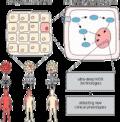- Record: found
- Abstract: found
- Article: found
Pathogenic postzygotic mosaicism in the tyrosine receptor kinase pathway: potential unidentified human disease hidden away in a few cells

Read this article at
Abstract
Gain‐of‐function mutations in the receptor tyrosine kinase pathway are often lethal; yet, it might be tolerated at very low frequencies as postzygotic mosaics resulting in a vast range of new phenotypes, unknown before the detection of the mosaic disorder. With the advent of ultra‐accurate next‐generation sequencing, these undercharacterized mosaics hidden in a few cells can now be better characterized in terms of their biological relevance in disease.
Abstract
Mutations occurring during embryonic development affect only a subset of cells resulting in two or more distinct cell populations that are present at different levels, also known as postzygotic mosaicism (PZM). Although PZM is a common biological phenomenon, it is often overlooked as a source of disease due to the challenges associated with its detection and characterization, especially for very low‐frequency variants. Moreover, PZM can cause a different phenotype compared to constitutional mutations. Especially, lethal mutations in receptor tyrosine kinase (RTK) pathway genes, which exist only in a mosaic state, can have completely new clinical manifestations and can look very different from the associated monogenic disorder. However, some key questions are still not addressed, such as the level of mosaicism resulting in a pathogenic phenotype and how the clinical outcome changes with the development and age. Addressing these questions is not trivial as we require methods with the sensitivity to capture some of these variants hidden away in very few cells. Recent ultra‐accurate deep‐sequencing approaches can now identify these low‐level mosaics and will be central to understand systemic and local effects of mosaicism in the RTK pathway. The main focus of this review is to highlight the importance of low‐level mosaics and the need to include their detection in studies of genomic variation associated with disease.
Related collections
Most cited references74
- Record: found
- Abstract: found
- Article: not found
Age-related clonal hematopoiesis associated with adverse outcomes.
- Record: found
- Abstract: found
- Article: not found

